General RiverWare
Data Object and Slot Descriptions
Description Tab Added
A tab was added to the Data Object to allow the user to provide a description of the object. See screenshot. Descriptions can be copied/pasted to/from the system clipboard or printed directly to a printer or file.When printed, all of the descriptions for the slots on the object are also printed. See Description Tab in User Interface for more information.
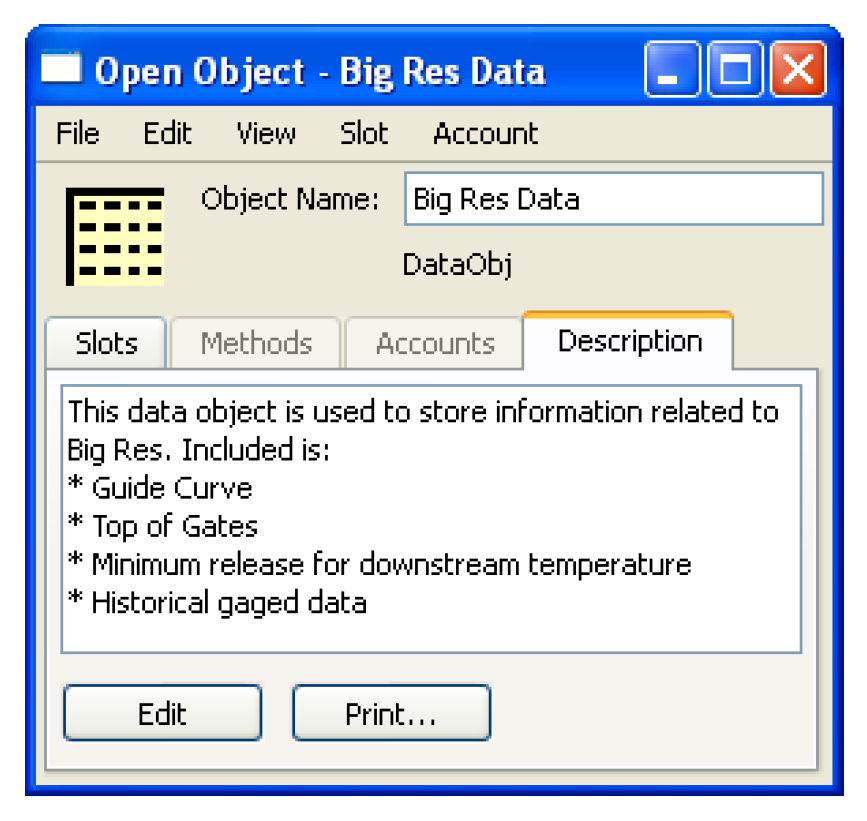
Description of Slots on Data Object
Any slot on a data object can now have a description as shown in the screenshot. This description is accessed from the View Add Description or View Show Description (if it already exists). Descriptions can be copied/pasted to/from the system clipboard or printed directly to a printer or file. See Slot Descriptions in User Interface for more information.
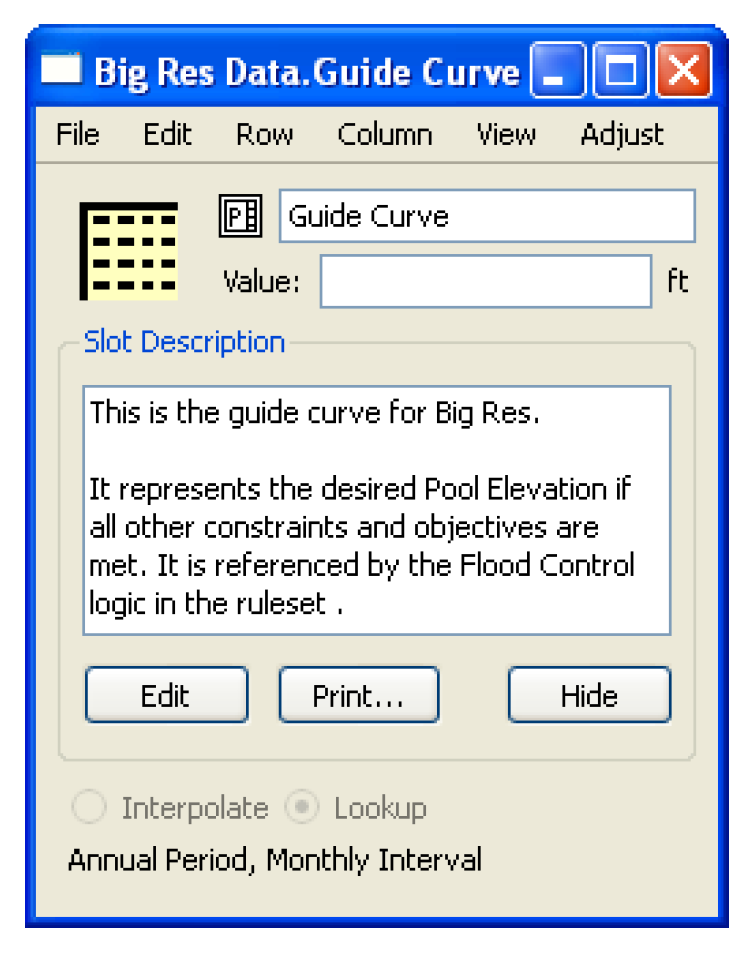
Diagnostics Manager Ported to Qt
The Diagnostics Manager and Diagnostics Configuration dialogs were re-implemented. The look and feel is the same as the previous windows but there are minor differences. See Diagnostics in Debugging and Analysis for documentation on the diagnostics interface.
File Loading
Dialogs modified
The following Load/Save file choosers were improved for better functionality:
• Load Model File
• Save Model File As
• Open RBS Ruleset / Open and Load
• Open Optimization Ruleset / Open and Load
In particular, the dialogs are now re-sizable and on Windows there is a toolbar on the left side with buttons to common locations like Desktop, My Recent Documents, and My Computer.
Tip: The My Recent Documents links is especially useful as it provides a history of models and directories that have been used. Once you select My Recent Documents, you may need to sort the column by clicking on Date Modified to see the more recently edited docs.
A default file extension filtering was added. The user can filter model files by:
• *mdl, *.mdl.gz *.rw and *.rw.gz (default)
• gzip Files (*.gz)
• All *
For RPL sets, the filters include
• RuleSet files (*.rls, *.rls.gz)
• gzip files (*.gz)
• All (*)
In addition, the user can use asterisks (*) as wildcards in the File name to further filter by file types.
Tip: With this default filtering, it becomes even more convenient to use one of these extensions when naming models and rulesets
See Loading Models in User Interface for more information.
Re-open Model or Ruleset from File menu
Menu options were added to allow the user to “Reopen” files. These options allow the user to re-open commonly used files saving the user a step locating the file. See Reloading Models in User Interface for more information. This option was added to the following:
• Model Files: On the File menus on the RiverWare workspace, a menu was added to allow the user to Reopen Model.
• Rulesets: From the Policy Ruleset, and Policy Optimization Ruleset menus on the RiverWare workspace, menus were added to allow the user to Reopen or Reopen and Load a ruleset.
• SCTs: From the main Workspace Utilities SCT menu, options were added to allow the user to Reopen an SCT. This menu also exists on the SCT’s File menu.
Import/Export
Export/Import of Links, Accounts and Supplies
When exporting objects, the user is now able to specify that links, accounts and/or supplies are to be included in the action.
Import Object Location
The object import behavior now places objects at their original locations (coordinates) on the workspace. When objects are imported they become the new workspace selection and at least one of the objects is scrolled into view. The user can then move all the objects or use the Subbasin Manager dialog to easily define a new subbasin containing all of the selected objects. This allows the user to more permanently associate imported objects with each other. Also, when importing objects, RiverWare now includes the accounting system coordinates. Previously these were only included when saving a model file.
Import Paste Slot Data
Import Paste was implemented in the standard Slot dialogs, supporting copying from an external tabular data application (e.g. Microsoft Excel) into RiverWare slots. This is supported for all Series Slots and Table Slots, including Periodic Slots. See Import Paste in User Interface for more information.
Link Editor
The link editor was re-implemented for better usability and functionality. It now shows existing links in a tree-view layout. Links can be created or deleted directly from this dialog. See Edit Links Dialog in Getting Started Building a Model for more information.
Tip: Quick links, using the right mouse, select the workspace, is still the quickest way to create or delete links.
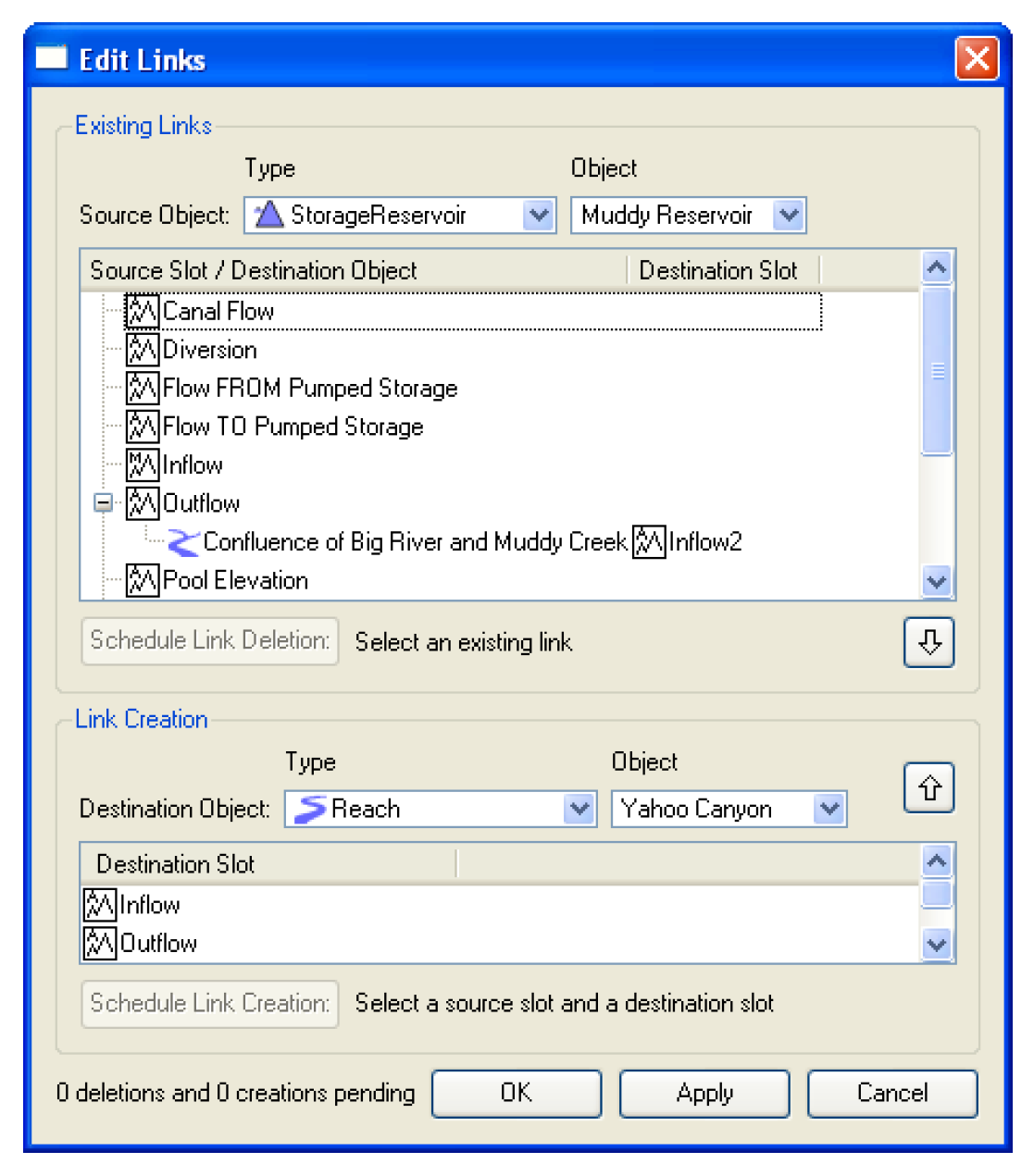
Performance
File loading of compressed files
A better model file loading mechanism was implemented to speed up the loading of gzip compressed files on Windows. File load time should be increased by approximately 20%.
Run Length Encoding
The model file format has been modified to use run-length encoding where possible for flags and data. To maximize the ability to use this encoding for flags, the flags series is written out separately from the data series. Small model files might get slightly larger, but most large model files will get smaller especially if they are large in the number of timesteps.
Plotting
Date Display Marker
When enabled, an automatic red vertical marker line is shown at the date displayed in the date time spinner in the toolbar. The user enables/disables this marker using a button next to the date scroll spinner. Note, the marker line can be used when a Global Time Scroll operation occurs. Global Time Scroll operations synch all dialogs to the selected date. It can be selected from the right-click context menu on slots and plots.
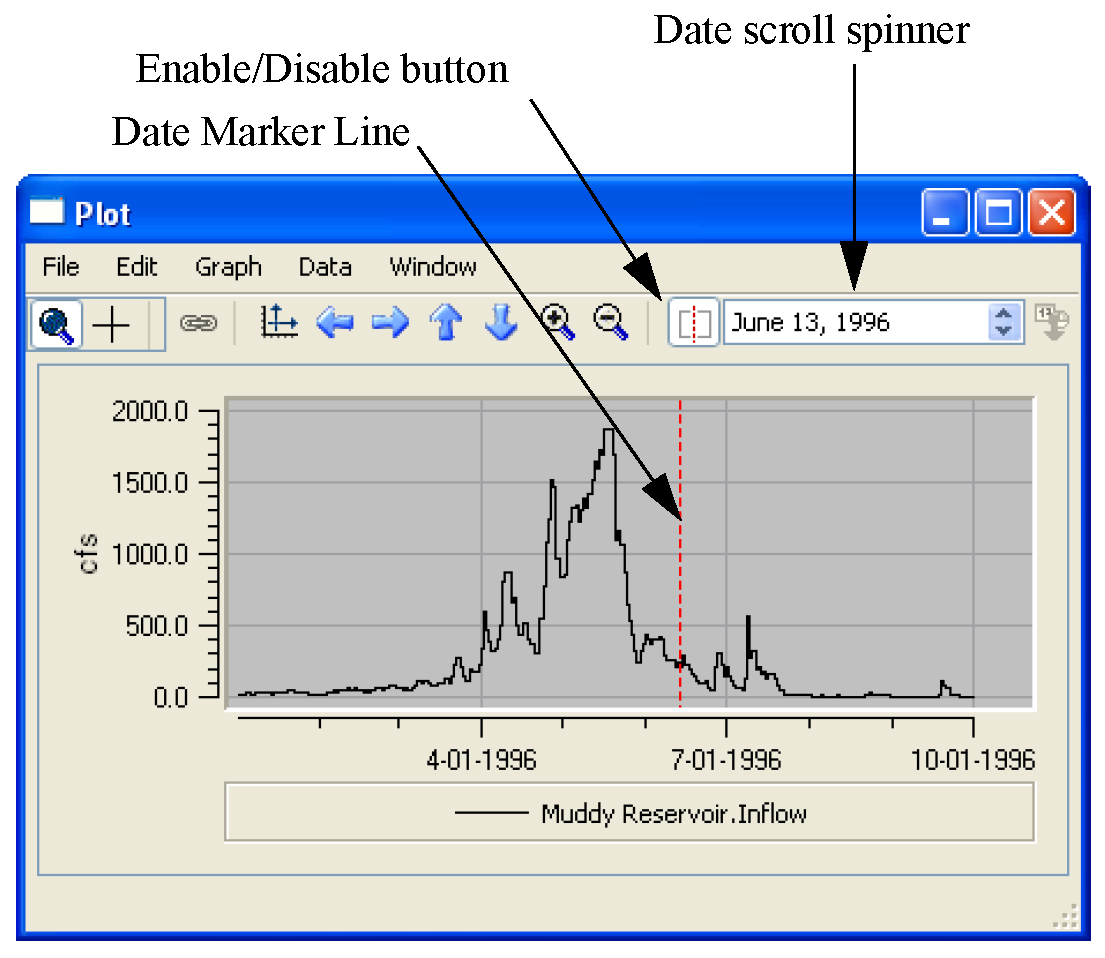
Multi-layout Plots
Multi-layout plots (2x2, 3x2, 3X3, etc) now plot better and fit on the screen.
Periodic Slot Plotting
Plotting of periodic slots was enhanced so that values at the begin time and end time of the specified plot time range are plotted, as well as any points defined in the periodic slot that fall into the plot time range. This ensures that the periodic slot line is plotted even if no defined points in the periodic slot fall into the plot time range, and also ensures that in the case where defined periodic slot points fall into the time range, that the periodic slot line is plotted from the full left side to the right side of the graph instead of being cut off at defined periodic slot points.
Probability Scale
A true probability scale was added to plotting in RiverWare. When exceedence percent values from a statistical slot are graphed from the open slot or open object dialogs, they will automatically be plotted with the true probability scale. This scale has 50% as the center line, and the scale gradations go symmetrically and irregularly (using probability scale) outward to values approaching 0 and 100 as seen on normal probability paper. This replaces the “faux” scale that was previously implemented to plot standard normal variables. See Plotting a Statistical Table Slot in User Interface for more information.
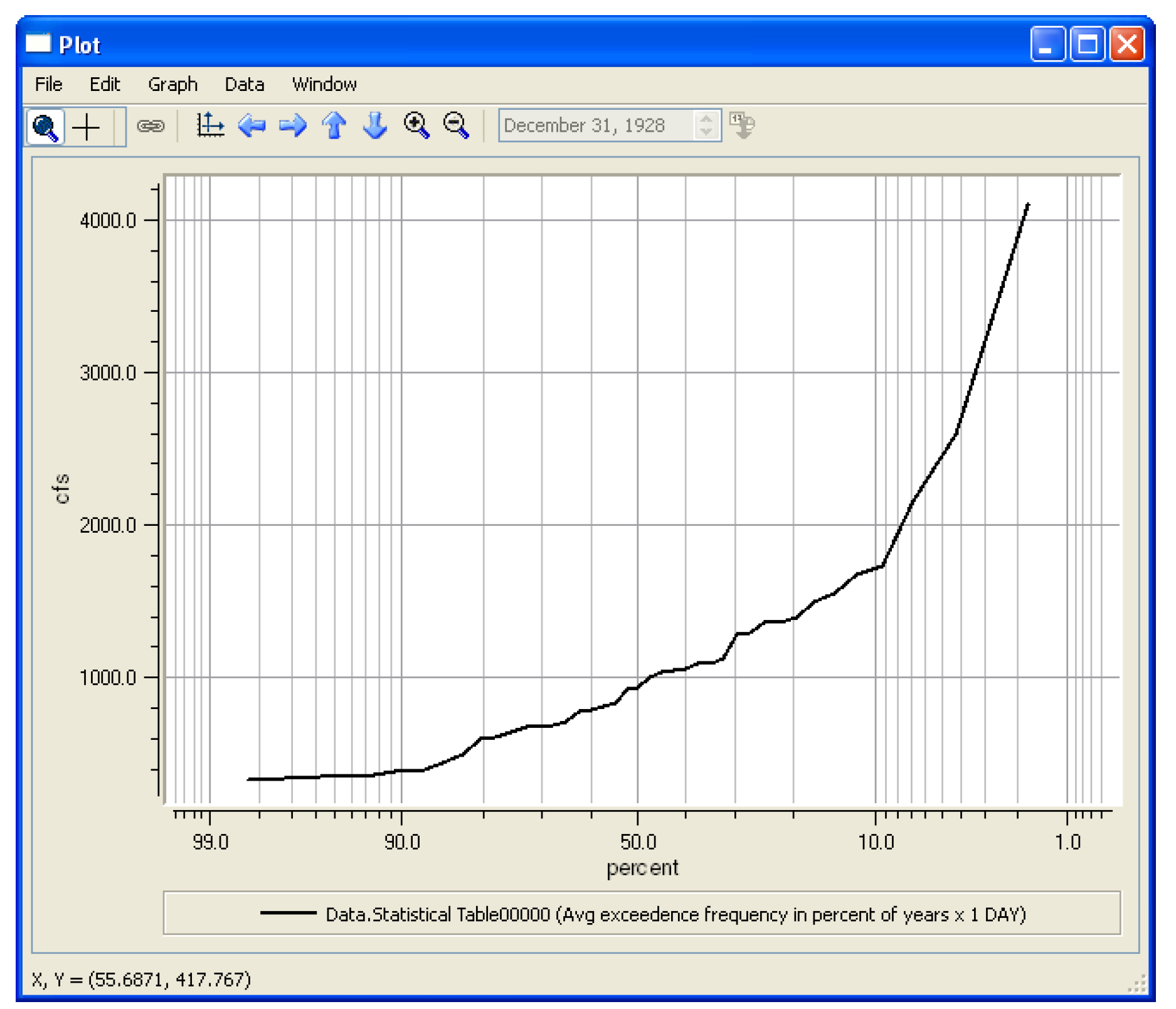
Time Labeling
Better time labeling was added to plots that displaying time. Ticks are now generated that are more appropriate to the range of time being shown. Instead of the random date labeling in previous releases, the new labeling chooses beginning of years, months, days or hours, as appropriate, for ticks and labeling. Also, the plot labeling was changed so that ticks on the time scale are marked and labeled at the beginning of day (hour 00:00) instead of in the middle of the day (hour 12:00). Time labeling is now automatic; the user is not able to select the number of tick marks or select that it is logarithmic. The user can still configure the time axis limits.
Run Analysis
Buttons were added to the Run Analysis dialog to allow the user to move objects up or down in the list. This allows the user to re-order objects by Custom, Name, Position, or Type.
Selector
Account Priority data
A filter was added to the selector to allow the user to select accounts by priority date. Two options were added: Junior To date and Senior To date.
Slot Type Filter
The Slot Type filter can be set to show only Scalar Slots and 1x1 Table Slots. This is useful in the new Slot Lists on the new SCT Tabs (Scalar and Other Slots tabs) -- both Scalar Slots and 1x1 Tables are shown within the same list.
Scalar Values
The selector dialogs were improved to now show Scalar Slot values in the column when the Slot Type Filter is set to “Scalar and 1X1 Table”. This allows the user to see the value of the slot when making selections.
Slots
Column widths
On the open slot dialog, the “Fit/Grow” column-width adjustment operations were improved to take into account the increased width of “bolded” header text, used to indicate selected columns.
Convergence
On the Configure Slot dialog, the display of convergence types Absolute, Unit Percent, and Percent were re-labeled to better show their meaning. In particular, if the Absolute or Unit Percent is chosen, the unit that is to be used is now shown in the dialog. Documentation of the convergence criteria was added Configure Slot Dialog in User Interface.
Global Slot Configuration Dialog
A global slot configuration dialog called Configure Existing Slots was added. This dialog is accessed from the Workspace Slots Configure Slots and allows the user to select one or more slots (using the selector) and configure all or selected slots. Configuration options include: User Units, Display Format, Convergence, and Unit Type for Slots on Data Objects. See Global Slot Configuration in User Interface for more information.
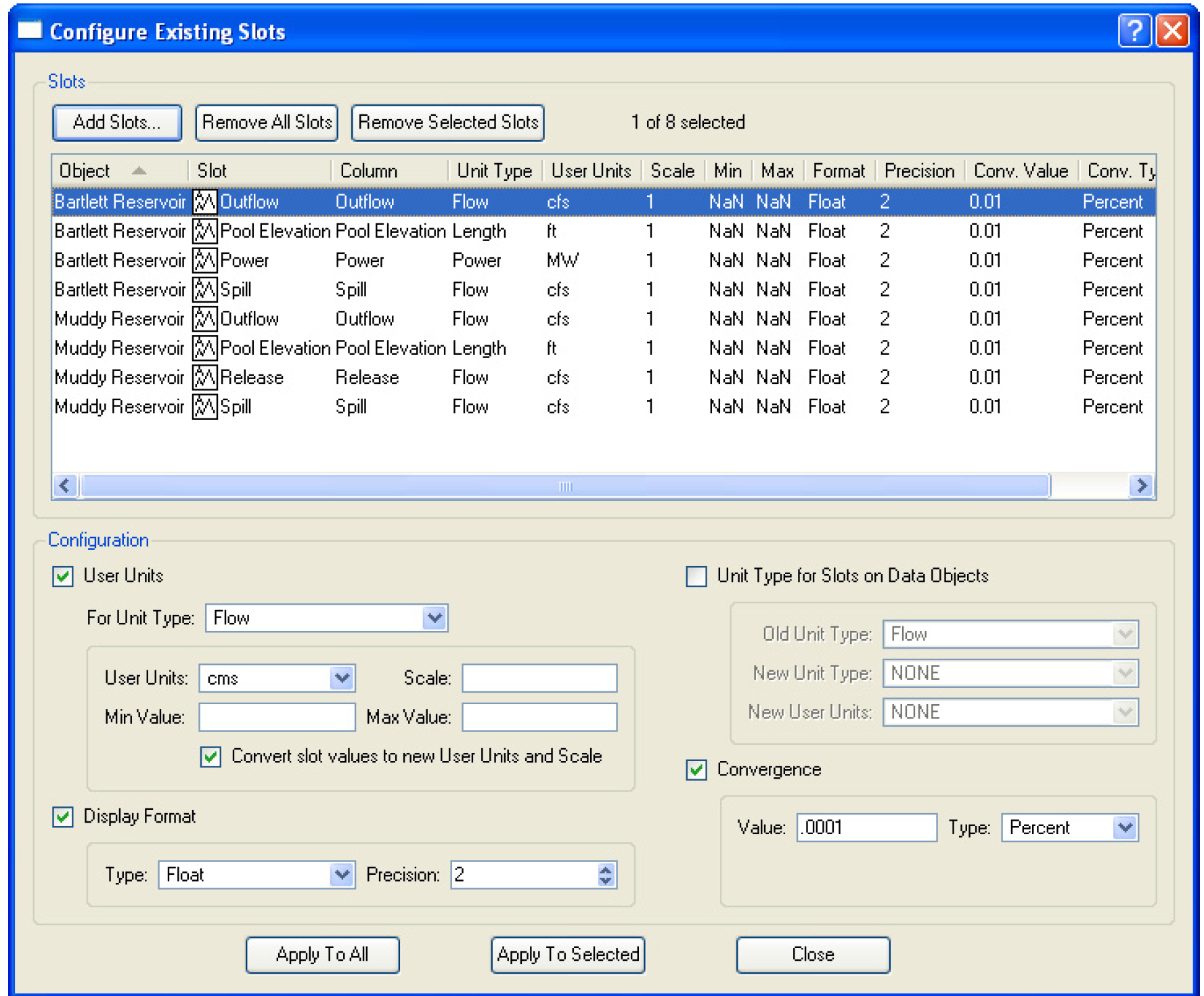
Integer Indexed Series Slots
Users can now add Integer Indexed Series and Agg Series slots to Data Objects. These slots behave like timeseries but are indexed by integer (1, 2, 3, ...) instead of date. These slots were implemented to work with the Iterative Mode of Multiple Run Management (i.e. each value in the slot represents a run) but can be useful for other purposes. More information on integer indexed series can be found here Integer-indexed Series and Agg Series Slots in User Interface. More information on iterative mode of MRM can be found Iterative Mode Configuration.
Periodic Slot re-implementation
The periodic slot dialog was re-implemented to be more similar to other slots. The user can now do the same actions that are available on other slots like:
• Multiple-Cell editing
• Multiple cell Copy and Paste operations, including Export Copy
• Import Paste (to and from the system clipboard)
• Fill Values Below (with value of the selected cell)
• Replace NaNs Below (with value of the selected cell)
• Interpolate vertically between the values of two selected cells, or a range of selected cells
• Adjust Values (of an arbitrary selection of cells)
• Column Sum Row (optionally shown as the bottom row)
• User Supplied Text Descriptions (on Periodic Slots on Data Objects)
• Column width Adjust Operations (five different operations)
Series Display Compression
The compression of series slots feature has been added. See Series Display Compression in User Interface for more information. This display feature allows the user to filter the data that is shown. The filtering options include:
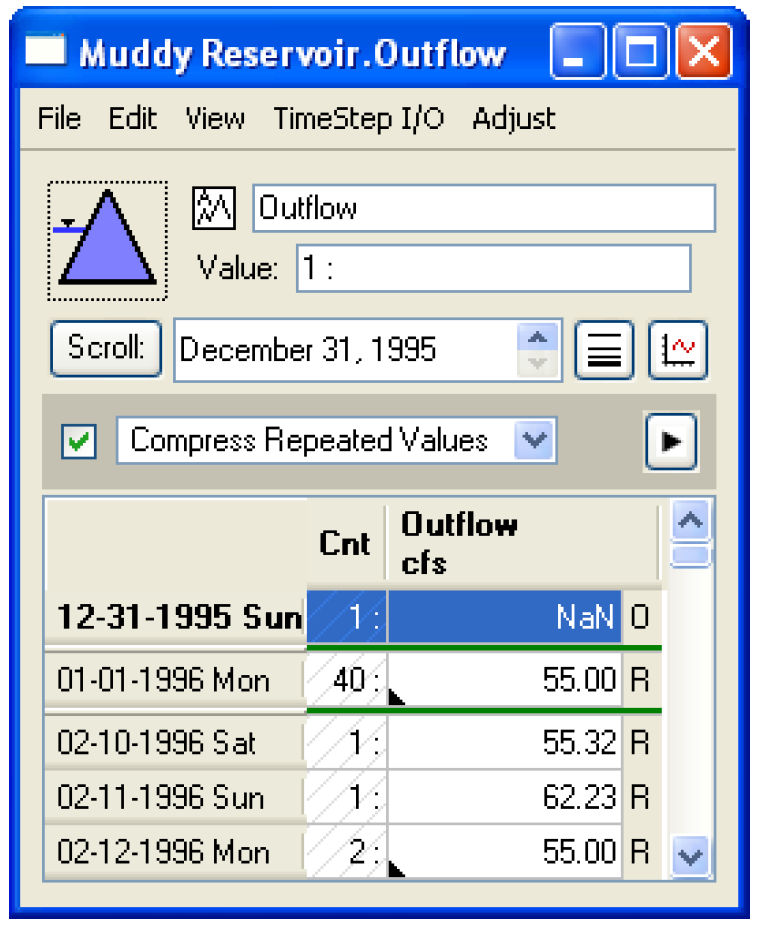
• Compress Repeated Values (shown to the right)
• Hide NaN Values
• Hide Value: 0 (or other user defined value)
• Hide NaNs and Value: 0 (or other user defined value)
• Show Values: 0 (or other user defined value)
• Show NaNs and Values: 0 (or other user defined value)
• Show Values <= 0 (or other user defined value)
• Show Values >= 0 (or other user defined value)
When deciding if a value should be shown or not. The utility uses the selected Precision Type. Precision Types may be set to one of the following options:
• Display
• Convergence
• Exact
Slot Configuration
On the Configure Slot and slot Configure Timeseries dialog, the Object, Slot, and Account (where applicable) is now more clearly indicated. Also, on the Configure Timeseries, there is now a button to allow the user to show the Run Period (and the Accounting Period for accounting slots).
Slot Order
On open objects, the user can now initialize the custom order from any of the automatic sort orders: Object Name, Object type, or Object Icon Position (vertical, on Simulation canvas). The Up and Down icon buttons can then be used to further customize the slot order. See Sorting Slots in User Interface
Statistical Slots
The statistical slots were modified to :
• display partial duration frequency functions (min and max)
• display value duration frequency functions (min, max, and avg)
• display fully specified date column where applicable
• allow a different frequency calculation method
• add an option to plot all data columns of value duration results.
See Statistical Table Slots in User Interface for more information
Snapshot Manager
The Snapshot Manager dialog was re-implemented and enhanced. See Snapshots in Output Utilities and Data Visualization for more information. Highlights include:
• New columns have been added to display the number of slots contained within the snapshot and a timestamp indicated the date and time when the snapshot was created.
• A variety of slot order options have been added to the Snapshot Manager dialog including up and down arrow buttons and a Sort pull down menu. The typical cut, copy, paste, remove, select all, invert selection, and add slots menu items are available within the Slots pull down menu.
• Removing a Slot from the Snapshot slot list will not remove it from previously created Snapshot Objects. Nor will deleting the original Slot (e.g. an original Slot on a Data Object)
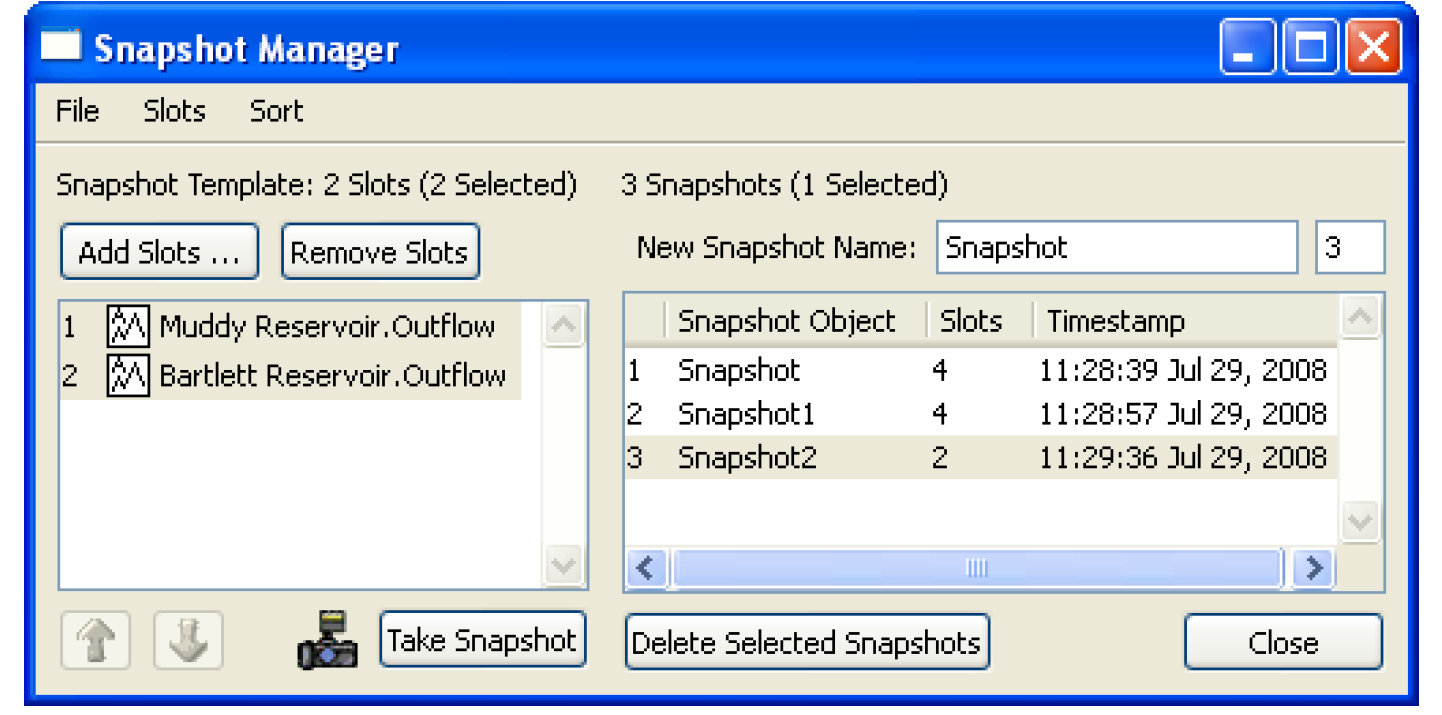
Software Technology Changes
The 5.0 release is a major milestone in RiverWare development. After many years of removing dialogs that use the “Galaxy” graphical user interface support library, all Galaxy dialogs have been replaced and Galaxy is no longer used by RiverWare.
Following is complete list of major software technology changes that have been implemented in RiverWare 5.0:
• Completed removal of the “Galaxy” GUI support library. This has been replaced by Qt.
• Began the port from (Trolltech) Qt3 to Qt4 using the Qt3-Compatibility support library.
• Completed port of Qwt (plotting package) from version 0 to version 5.
• Upgraded the Tool Command Language (TCL) used for model saving and loading from version 8.3 to version 8.5.
Subbasin Manager
The Subbasin Manager dialog has been re-implemented. It is now divided into three tabs which represent the User Defined subbasins, Automatic subbasins, and Object Membership of subbasins. On the Object Membership tab the user selects an object and subbasins containing this object are then shown in the list below along with the number of objects within the subbasins and the type of the subbasins. The subbasin list may be expanded in tree view to show all the objects contained within each subbasin on the list. This dialog now provides better support for re-organizing the list of subbasins and opening subbasins directly from the manager. For more information, see Subbasin Manager in User Interface.
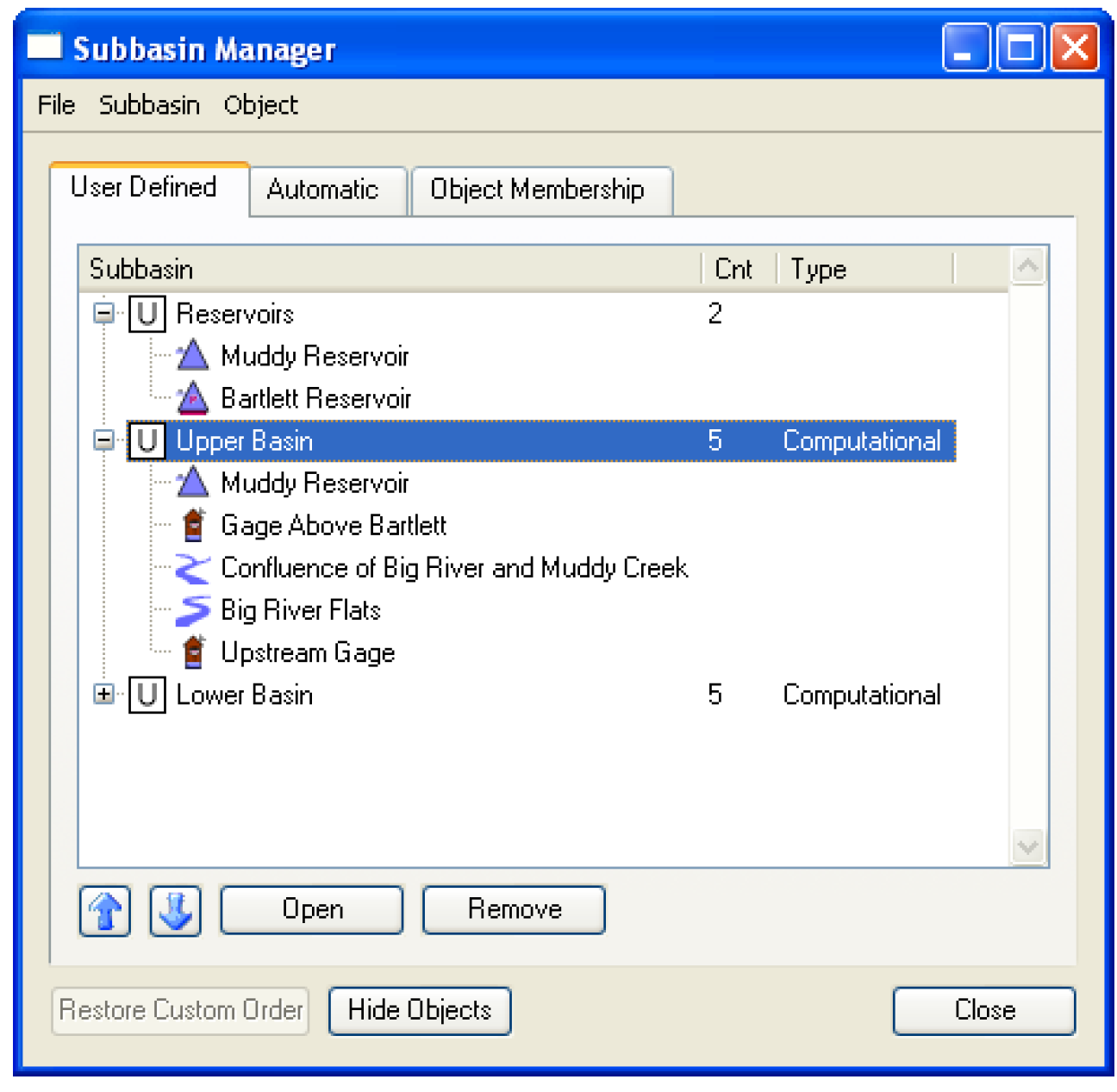
Units
Unit Converter
The Unit Converter was re-implemented. See Unit Converter Dialog in User Interface for more information. Now there is better support for varying timesteps (i.e. months and year). The user can select the length of the month or year to use (where applicable). Also, there are quick buttons for the common unit types Flow, Volume, Area, and Length. Also, calculations are automatic; hitting enter is not necessary.
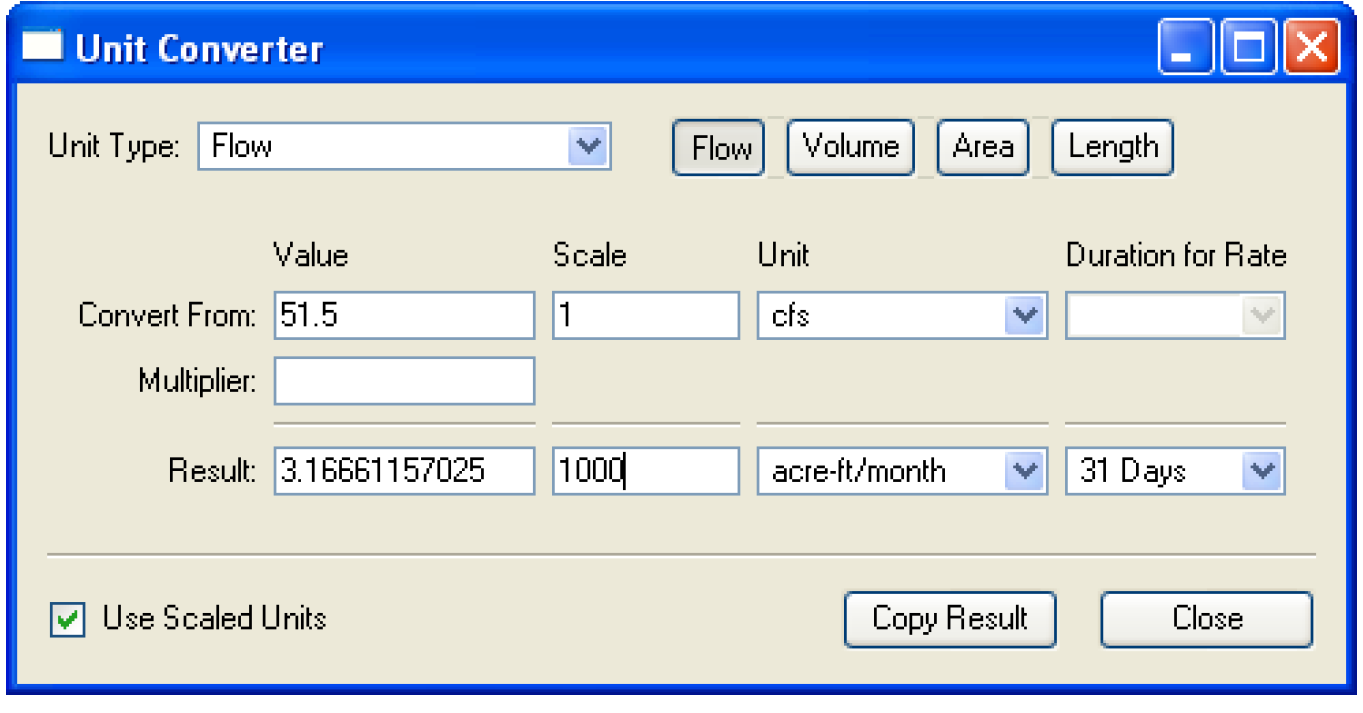
New Units
The following units were added to the units file. Additional units can be defined by the user in the “units” file in the RiverWare installation directory.
• m3/month: RiverWare displays it as m3/month.
• m3/year: RiverWare displays it as m3/year.
Workspace - Canvas Selection
The selected Workspace Canvas (Simulation or Accounting) is now saved in the RiverWare model file and the model is automatically opened to that view. Now, if you close a model with the accounting view shown, it will re-open to the accounting canvas.
Revised: 01/05/2024